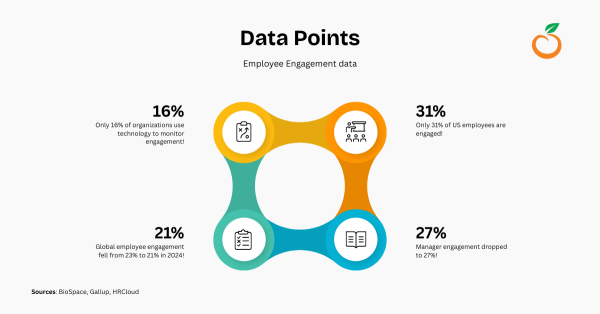Employee engagement is about much more than perks, ping-pong tables, or free snacks. It’s about how people feel, connect, and find meaning in their work. The World Happiness Report 2024 (WHR 2024) offers insights that are deeply relevant to HR leaders who want to improve engagement—and run better employee surveys. Although WHR doesn’t always frame everything explicitly in “employee engagement” terms, its findings on well-being, satisfaction, age, and trust map closely to the drivers of engagement.
In this blog, we’ll explore what the WHR tells us about engagement, what the data means for workplaces, why employee surveys matter, and practical steps HR leaders can take to act on these insights.
What the 2024 World Happiness Report Says
Here are some of the key findings from WHR 2024 that link to how people experience their work and life—insights that inform employee engagement.
Life Stage, Generational Differences, and Happiness
-
WHR 2024 examines happiness across different ages and birth cohorts. It finds that younger people (born since ~1980) generally report lower levels of life satisfaction than older generations. (files.worldhappiness.report)
-
In many wealthy nations (e.g., North America, Western Europe), the happiness of the young (15-to-24 years) has declined sharply. In some cases, young people are less satisfied than older counterparts. (files.worldhappiness.report)
-
Happiness inequality (differences in how happy people are) has been rising in many parts of the world except Europe. That is, some groups are pulling ahead, others are falling further behind. (files.worldhappiness.report)
Emotional Well-Being, Work, and Life Context
-
While the WHR focuses broadly on life satisfaction and well-being, many of its measures overlap with things that matter inside work: social support, feeling free to make life choices, trust, generosity, etc. These are psychological conditions also linked to engagement. (files.worldhappiness.report)
-
In WHR 2024, life evaluations (how positively people evaluate their lives) decline somewhat with age in many countries, but the decline is much steeper for younger cohorts in certain places. (files.worldhappiness.report)
Broader Trends Relevant to Work
-
The report shows that well-being among younger people has fallen in many regions, particularly in North America and Western Europe. (files.worldhappiness.report)
-
These downward trends among younger people are worrying, because they may signal risk of disengagement, mental health stress, and lower life satisfaction—things that bleed into work performance.
How These Findings Relate to Employee Engagement
“Engagement” at work is often defined as how involved, enthusiastic, and committed an employee feels toward their work and organization. Many of WHR’s findings map to what engagement requires—satisfaction, meaning, trust, autonomy, fairness.
Here’s how:
|
WHR Finding |
Implications for Employee Engagement |
|
Younger generations report lower life satisfaction |
Gen Z / younger workers may have higher risk of disengagement if work isn’t meaningful, flexible, supportive |
|
Rising happiness inequality |
Disparities in experience among employees (across roles, geographies, background) will hurt morale & retention unless addressed |
|
Social support, trust, freedom to make life choices correlate with happiness |
Key drivers for engagement: managers must foster trust, allow autonomy, enable work-life balance |
|
Decline among youth in wealthy countries |
Even in “rich” contexts, fulfilling core psychological needs (autonomy, mastery, purpose) matters more than material benefits |
Why Running Employee Surveys Is Critical
Given what WHR shows us, surveying employees is not a “nice to have”—it’s essential. Here’s why:
-
Detect early signals of disengagement. If young people are reporting declining life satisfaction generally, your workplace needs to see whether similar trends appear inside the organization.
-
Measure what WHR can’t. WHR data is external and broad; internal surveys capture specific workplace drivers: leadership trust, job clarity, recognition, fairness.
-
Segment by age/generation. WHR shows generational differences. In your surveys, ask demographic questions (age group, location, role) so you can see whether younger employees are less happy or less engaged, and tailor interventions.
-
Check psychological needs: autonomy, mastery, meaning. WHR shows that freedom and social support matter deeply—so survey items that measure those things (e.g. “I have the freedom to make choices about how I work”, “I feel supported by my manager”) will be very predictive of engagement.
-
Benchmark over time. The WHR tracks trends over years. Internal surveys allow you to track changes—improvement or decline—and act before problems become large.
-
Action implies trust. If people see survey results being acted upon—not just collected—that builds trust, improves transparency, and increases engagement itself.
Data Points from Related Sources (Gallup, etc.)

While WHR is very helpful, there are also more direct engagement metrics from related studies:
-
Global employee engagement fell from 23% in 2023 to 21% in 2024 according to Gallup. (BioSpace)
-
In the U.S., employee engagement in 2024 was at its lowest in a decade: only 31% of employees are engaged. (Gallup.com)
-
Manager engagement dropped to 27%, while many individual contributors stayed near prior levels. (BioSpace)
These data underline the urgency: if the broad population (as measured by WHR) is seeing less happiness, workplaces will likely see engagement issues unless addressed.
What Organizations Should Do: Applying These Lessons
Here are practical steps, drawn from what WHR and related engagement research teach us, that HR leaders should take to build engagement and well-being inside their organizations.
H1: Survey Design & Frequency
-
Use pulse surveys (short, frequent) rather than only annual surveys.
-
Include items that measure life satisfaction or well-being as well as work context (job clarity, autonomy, trust, social support).
-
Disaggregate data by age, role, location, and generation to spot whether, for example, younger staff are suffering more.
H2: Leadership & Trust
-
WHR shows that trust, freedom, and social support strongly correlate with happiness. In the workplace, employees’ trust in managers and how decisions are made matter hugely.
-
Training for leaders to communicate transparently, listen well, support flexibility, and recognize effort.
H3: Autonomy, Meaning & Purpose
-
Design work roles so that employees have autonomy—control over how and when they work.
-
Make the purpose of work explicit: connect individual tasks to mission, impact.
-
Give opportunities for mastery: learning, growth, challenge.
H4: Support Well-Being & Mental Health
-
WHR indicates younger people are feeling less satisfied overall—these cohorts are vulnerable.
-
Include mental health discussion in surveys and engagement—ask how stressed people feel, whether they have support.
-
Policies around flexibility, rest, family time contribute to well-being.
H5: Follow-Up and Action
-
Survey results must lead to visible action—leaders must close feedback loops.
-
Set OKRs or priorities around engagement, inclusion, fairness.
-
Regular check-ins, monitoring, course corrections.
Relating It Back to Employee Surveys: Why They Should Be Regular and Deep
Employee surveys are the tool by which organizations internalize findings like those of WHR. To get maximum value:
-
Make them regular (quarterly or bi-annual pulses plus anomaly surveys).
-
Design questions so that they map to core happiness/happiness drivers: trust, purpose, autonomy, support.
-
Use validated scales or benchmark questions so you can compare across time.
-
Protect anonymity where needed so people feel safe to respond honestly.
-
Communicate results transparently and act visibly; lack of action is among biggest trust-breakers.
The World Happiness Report 2024 gives us a powerful reminder: life satisfaction, happiness, and well-being are shifting—especially among younger people. These changes are not separate from work—they bleed into engagement, performance, retention, and culture.
If organizations want to keep people motivated, productive, and loyal, they cannot keep treating engagement as a “nice HR metric.” It must be anchored in data about people's lives—measured via employee surveys, acted on by leaders, and deeply integrated into culture.
The happiest, most productive workplaces of tomorrow will be those that listen, understand, and adapt—not just to business goals, but to the wellbeing of their people.
